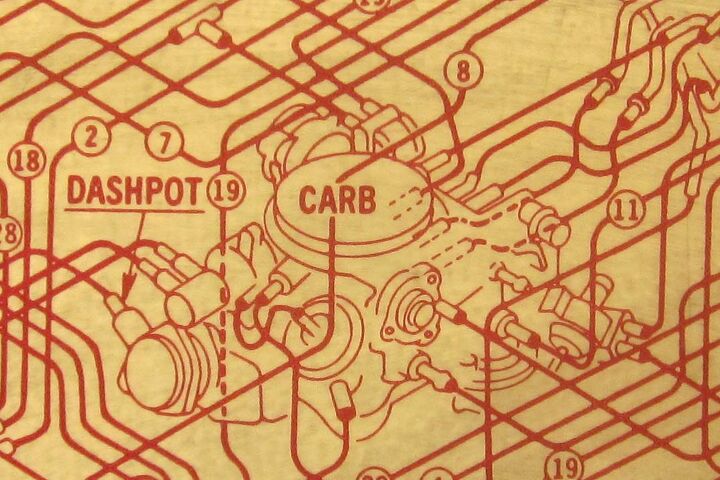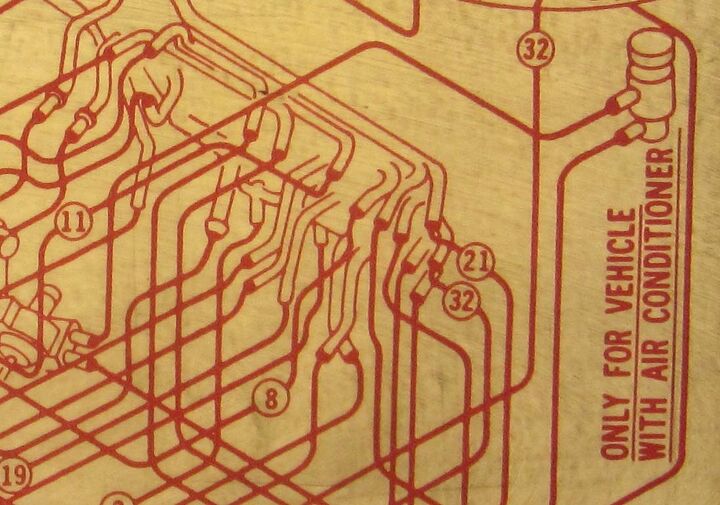Quick, Why Won't This Car Pass the Smog Check?

I’ve had more Honda Civics than any other type of car (at least one example of each of the first five Civic generations), at one point owning two ’85 hatches and a CRX at the same time. The mid-80s CVCC cars were great to drive and very reliable (provided you didn’t overheat the engine— ever), but when California tightened up smog-check requirements in the early 2000s it became impossible to keep one registered. Why? This.
If I ever decide to get a huge tattoo across my back, it will probably be this Vacuum Hose Routing Diagram for carbureted 1984-86 Civics. It’s as elegant as Harry Beck’s map of the London Tube system, yet terrifyingly complex to the backyard Civic mechanic who just wants to pass California’s dyno-based emissions test. Every time I spot one in the junkyard, I stop to check it out… and remind myself how happy I am with the bone-simple EFI plumbing under the hood of my ’92 Civic DX.
Why so ludicrously complicated? The CVCC stratified-charge system started out as a fairly simple setup: you had a big combustion chamber that got a lean air-fuel mix, a little combustion chamber that got a rich mix and the spark, and a two-in-one carburetor that supplied both chambers as needed. This worked great through the 1970s and into the 1980s, but as American— and Californian— emissions requirements got stricter, Honda had to add a bunch of auxiliary systems to ensure that the car wouldn’t spew out too much HC, CO, and/or NOx out the tailpipe, no matter what the driving conditions.
So, let’s say it’s 42 degrees out and your CRX has just hit the downhill grade on I-80 at Donner Pass. There’s a sensor to tell the car’s primitive ECU that external air temperature is below 60 degrees, another one that can tell you’re at high altitude, and yet another to detect that you’ve just backed off on the throttle. This information gets turned into vacuum signals, via a bunch of vacuum solenoids and valves, and then more vacuum signals are sent to various vacuum- or electro-vacuum-actuated devices, which adjust the fuel-delivery system accordingly. If any one of the hoses or devices in this system stops working, the car will probably run just fine… but it will almost certainly fail the tailpipe emissions test.
So (after hundreds of hours of testing and parts replacement— per car— in order to get my cars through the smog check), that’s why I got rid of my CVCC-ized third-gen Civics and swore to drive only fuel-injected versions from that point on.

Murilee Martin is the pen name of Phil Greden, a writer who has lived in Minnesota, California, Georgia and (now) Colorado. He has toiled at copywriting, technical writing, junkmail writing, fiction writing and now automotive writing. He has owned many terrible vehicles and some good ones. He spends a great deal of time in self-service junkyards. These days, he writes for publications including Autoweek, Autoblog, Hagerty, The Truth About Cars and Capital One.
More by Murilee Martin
Latest Car Reviews
Read moreLatest Product Reviews
Read moreRecent Comments
- MaintenanceCosts Other sources seem to think that the "electric Highlander" will be built on TNGA and that the other 3-row will be on an all-new EV-specific platform. In that case, why bother building the first one at all?
- THX1136 Two thoughts as I read through the article. 1) I really like the fins on this compared to the others. For me this is a jet while the others were propeller driven craft in appearance.2) The mention of the wider whitewalls brought to mind a vague memory. After the wider version fell out of favor I seem to remember that one could buy add-on wide whitewalls only that fit on top of the tire so the older look could be maintained. I remember they would look relatively okay until the add-on would start to ripple and bow out indicating their exact nature. Thanks for the write up, Corey. Looking forward to what's next.
- Analoggrotto It's bad enough we have to read your endless Hyundai Kia Genesis shilling, we don't want to hear actually it too. We spend good money on speakers, headphones and amplifiers!
- Redapple2 Worthy of a book
- Pig_Iron This message is for Matthew Guy. I just want to say thank you for the photo article titled Tailgate Party: Ford Talks Truck Innovations. It was really interesting. I did not see on the home page and almost would have missed it. I think it should be posted like Corey's Cadillac series. 🙂












































Comments
Join the conversation
I'd loved my '83 Civic S 1500 hatch... 160k flawless miles, 30 mpg easy. By today's standards it would be considered dog slow, but back then (and as 16 year old) it seemed very quick.
If CA is so bent on reducing smog, why do they insist on building all those huge housing tracts, freeways, and strip malls? Why do drivers insist on owning SUV's where it rarely snows? Why did they do away with the light rail in LA? Also, they can't blame Detroit for smog and sprawl, when Imports dominate there!